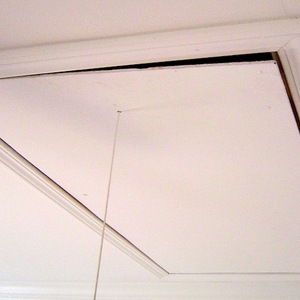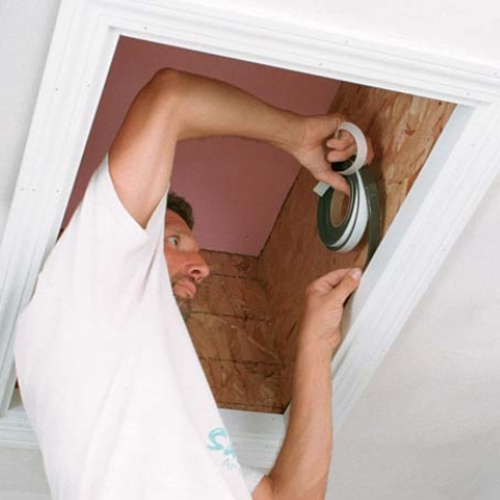Stop the air leaks and save big on your heating and cooling bills
with Mike Guertin

One of the biggest threats to comfort and energy efficiency is air escaping from your house into your unconditioned attic. Luckily, a leaky attic can often be the easiest and cheapest place to make energy-saving improvements. In this video series, remodeler Mike Guertin identifies common air leaks and shows you the best materials and methods for sealing them up right.
Video Transcript:
The EPA estimates that between 25 and 30 percent of the energy that we use to heat and cool our homes is lost due to the air leaks through the attic, the basement, and other places in a house. In this video series, we’re going to show you some simple techniques and off-the-shelf materials that you can use to air-seal up most all of the air leaks that you’ll find in an average attic. We’re going to show you how to seal up light fixtures in the ceiling, the junction box for ceiling-mounted fixtures, as well as recessed light cans. We’ll also look at some of the big holes, like the chase between a soffit, say, over some cabinet work. We’ll show you how to seal around electric wires and plumbing vent pipes. We’ll show you how to seal up the joints where drywall meets a top plate. We’ll show you how to seal the framing around knee walls. We’ll show you how to maintain proper air flow in an attic when you’re going to add extra insulation over the attic floor. And we’ll show you how to seal up the ductwork and ventilation fans. So in a few hours or a day in your attic sealing up these air leaks, you can save a significant amount on your energy bill.
Weekly Newsletter
Get building science and energy efficiency advice, plus special offers, in your inbox.








4 Comments
Air-Seal an Attic
All sounds good, but what if your attic is mostly a crawl space with duct work up there and no room for you to move around...unless you have a child sized body. What sealing can be done from the living space vs in the attic?
Response to Cat
Cramped attics and other inaccessible spaces are a problem to air seal. I categorize leaks into two types - those that have a direct path and those that have an indirect path. Direct path leaks can be pretty straightforward to seal. A recessed can light can usually be yanked out and replaced with an Insulation Contact Air Tight (ICAT) model from inside the living space or replaced with a ceiling mounted fixutre. An uncapped soffit cavity can be blocked up from inside the living space if you don't mind opening up the dropped soffit from below. And sealing up a gaps around an ceiling electric box can be handled by pulling the fixture. But sealing indirect air leaks is always a lot more difficult because there are multiple routes the air can take to reach each leak point in the attic. For instance, a leak along the top plate of a wall or through holes in the plate may originate at many spots far away - at gaps in electric outlets, gaps between the drywall and bottom plate of the wall and through the gap at the baseboard, wire and pipe holes through bottom plates into the floor cavity between first and second floor and so on. And even sealing a few intake leaks may be ineffective since other intake leaks will just leak more (this depends on the relative 'size' of the attic leak point as compared to the aggregate intake leak 'size.')
I approach interior air leak sealing with a 'bang for the labor buck' attitude. I start with blower diagnostic testing to quantify total air leakage. Then using zone pressure diagnostic (ZPD) practices (using a manometer to test different pressures between a common area within the house and separate rooms, the attic and some concealed spaces (like wall cavities), I try to narrow down the big leaks. ZPD along with some smoke testing leads me to the leak intake areas. Starting with the big obvious ones, I seal them up, then I do more ZPD and smoke tests to find intermediate leaks, seal them up. Periodic tests with the blower door leak rate and experience give me a sense of how far I've gone and whether it's worth continuing.
I was quite excited to come across this video on air sealing as I'm in the process of doing this in my 1953 cape cod. There seems to only be an introduction video with no links directing me to additional videos. Am I missing something? I know this video is quite old now but seems helpful.
Much thanks.
Develinsky, I'm guessing you already found them but just in case - the series of Fine Homebuilding videos re techniques to air seal the attic appear to be in the GBA library if you search "How to air-seal an attic". Also, Martin posted a detailed article in 2013 on the subject: https://www.greenbuildingadvisor.com/article/air-sealing-an-attic
Log in or create an account to post a comment.
Sign up Log in